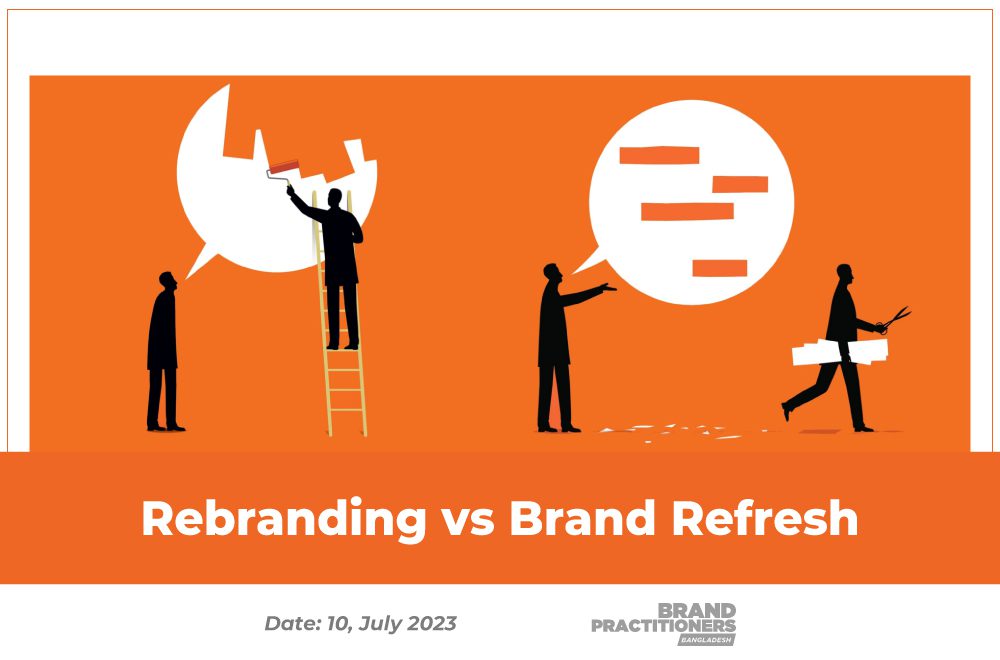Can you tell them apart? Both can help your company’s brand stay fresh and relevant, but there’s a world of difference between the two. It’s common knowledge that fashion trends fluctuate and eventually go out of style. But some managers forget that in a rapidly changing marketplace, so will a company’s branding.
After all, your brand message, identity, and positioning represents the core identity of your business, boiled down to a set of visually-recognizable standards that can easily capture the attention of your target audience. So when the market or your audience shifts – because of new competitors, consumer demands, trends or simply the changing times – so can your brand’s appeal.
Depending on the landscape, it may be time to protect the brand equity you’ve built and update your brand guidelines to align with the present conditions. That can include changes to your color schemes, brand story, logo design, new products, new fonts, etc. The good news is that you don’t have to abandon your core values (if you don’t want to) when rebranding or refreshing your company identity.
Any successful existing brand will attest, there will eventually come a time where you’ll need to adapt your company’s brand identity, brand image, value proposition, etc. in order to attract a new audience and satisfy current stakeholders in this ever-evolving marketplace. This concept is similar to a fashionista changing their style.
The logic is simple: if your target audience is changing, it’s best you change with them or get left behind.
But the question is, how much do you change? Do you completely abandon your old image and go in for a total makeover (i.e., complete rebrand)? Or do you keep the elements of your original style so that your clients can still recognize it – while refreshing your look with some new features the way you might go in for a new haircut or lipstick (i.e., brand refresh).
That’s the key difference between undertaking a rebrand and a brand refresh. While the two may sound like similar concepts, the process of a brand refresh as opposed to a rebrand is vastly different, as are their impacts on your organization. Let’s take a look at each one:´
Rebranding definition
Think of ditching your old wardrobe and replacing it entirely, piece by piece: unlike a brand refresh, rebranding is a total overhaul of the old brand identity. Here, a company completely overhauls its existing branding and reinvents its brand identity, from the brand story to the elements of its visual brand.
British fashion label Burberry is often cited as a leading example of a successful rebrand. More than a decade ago, the fashion house’s iconic check design was associated with football hooliganism, now it counts star Emma Watson as one of its brand ambassadors. How? It relied on a rebrand campaign that emphasized the company’s heritage and moved away from the check design to focus on trench coats, which are symbolic of classic, old-world fashion. In this example, Burberry didn’t need to redesign their products. Instead, they focused on revamping their brand image and brand positioning to fit their target market.
Of course, tearing down the old brand and building a new look from scratch is a consuming, often costly process, and one companies should not take lightly. When not carried out effectively or with purpose, brands risk alienating or confusing their existing customer base or employees. Further, a new brand identity rolled out the wrong way may not fit an evolving target audience.
Before embarking on a rebrand, companies should carefully consider whether to rebrand or not to rebrand and investigate tools which can help make the rebranding process as painless as possible.
For example, Templafy’s software keeps all your documents and templates brand compliant, automating the process of rolling out your new visual identity (i.e., new logo designs, typography, fonts, color palettes, etc.) across all your digital company content. The easy-to-use software is available across all devices and most office suites, helping to ensure a successful visual transition. That means you avoid customer confusion and potential rebrand failure with an embarrassing faux pas – like when an old logo crops up on a presentation deck where it definitely shouldn’t be.
Brand Refresh definition
This branding approach is more like a visit to the salon – same you, just sharper and more modern. Sometimes, small tweaks and a bit of restraint can be more effective than a makeover.
If you feel your current brand is working for your company and you want to remain recognizable to your existing customer base, a good brand refresh can give your company an updated, fresher feel without the need for total overhaul.
By updating the look and feel of your brand touchpoints (i.e., social media pages, marketing materials, storefronts, etc.), a brand refresh can easily help you maintain audience appeal with an updated look, create a clearer and more focused message, or reflect updates in your products or service.
Generally, a brand refresh will be centered around your existing visual elements – building on a recognizable image but giving it a fresher feel. For example, Mastercard’s subtle logo revamp is a great example of a highly successful brand refresh. Leading design firm Pentagram took the brand’s iconic 1990s red-and-yellow circle design and updated it with circles that were sleeker, smoother and more minimalist. It thus created a logo design better suited to today’s digital apps, while still retaining the brand’s instantly-recognizable colour palette and contours.
Editors note: Read how 3 global enterprises handled their logo update
The result? A brand that looks fresh and sharp while still keeping customers connected to its core business while attracting new customers.
One advantage of a brand refresh is that it is far less resource-intensive than a rebrand, meaning your company will use far fewer funds and manpower rolling it out. But that doesn’t mean you can relax about brand compliance! As with a rebrand, the effectiveness of your brand refresh depends on its successful implementation across your company, both inside and out. Unfortunately, this might prove tricky if your new look, tag line, logo, etc. have similar elements to the old, and can lead to sloppy mistakes from team members during the transition phase.
Here’s a hot tip: to ensure thorough implementation of your brand identity update, rely on Templafy’s document management software to automatically update your internal documents, and incentivize your team members to scan the workspace for any traces of the old logo on physical office paraphernalia.
Do you think it’s time for a rebrand? Not sure where to start? Check out Templafy’s Ultimate Rebranding Guide for a handy step-by-step checklist to ensure a smooth brand transition.













